The Microsoft Surface Laptop 2 Review: Surface Essentials
by Brett Howse on March 28, 2019 8:00 AM EST- Posted in
- Laptops
- Microsoft
- Surface
- Surface Laptop
- KBL-R
- Surface Laptop 2
System Performance
Due to Microsoft’s longer support windows, the original Surface Laptop’s dual-core Kaby Lake-U series processors were quickly surpassed when Intel updated to Kaby Lake Refresh, which offers twice the cores and twice the threads. The Surface Laptop 2 was announced in October 2018, and Microsoft solved the problem with a spec bump to KBL-R on both the Core i5 and Core i7 models.
The Core i5-8250U is a four-core, eight-thread CPU with a 1.6-3.4 GHz frequency range. There’s 6 MB of SmartCache, and a nominal 15-Watt TDP. The Core i7-8650U offers the same cores and threads, but bumps the cache up to 8 MB and CPU frequency to 1.9-4.2 GHz, which is a significant jump from the i5. The downside of Microsoft’s release cadence though is that Intel has since released their Whiskey Lake U series processors, which aren’t available in the Surface lineup yet, and Microsoft tends to refresh in October, but not always, so there’s no timeline for when they will be added.
The extra cores are nice, but Microsoft dropping the 4 GB model from the lineup is nicer, since 4 GB is really the low-end for RAM in a non-upgradable device. Offering just 8 or 16 GB of LPDDR3 is the correct choice, so it’s great to see that as the only two options on this model.
To test the performance of the Surface Laptop 2, the laptop was set to Best Performance and run through our standard laptop suite of tests. Comparisons are against other similar Ultrabooks. If you’d like to see how the Surface Laptop 2 compares to any other device we’ve tested, please check out our online Bench.
PCMark
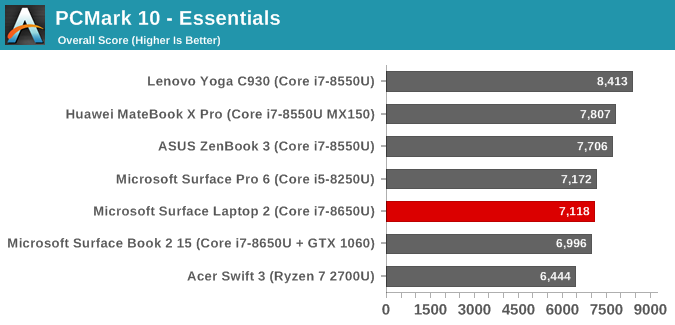
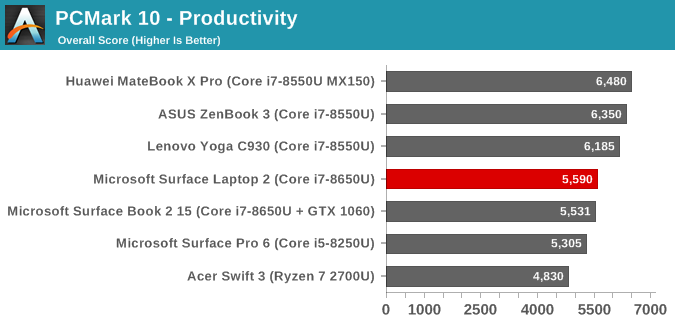
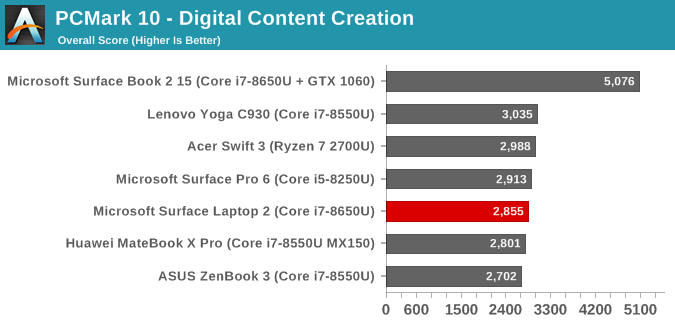
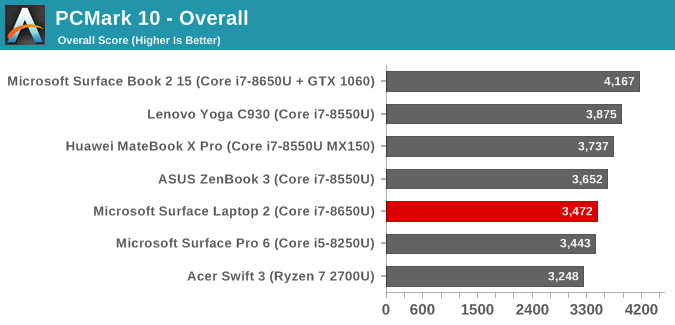
PCMark tests all aspects of a system’s performance level, from graphics to storage. The Surface Laptop 2 is mid-pack with the Core i7-8650U inside. The integrated GPU holds it back in the digital content creation score a bit, but overall it does about what you’d expect from an Ultrabook.
Cinebench
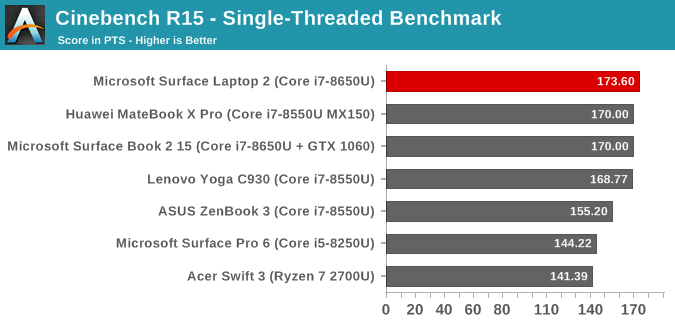
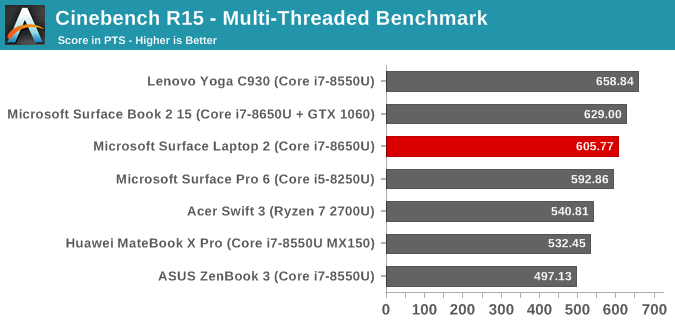
We’ve just got word that Maxon has updated this tried and true benchmark to R20 so we’ll be slowly moving to that updated version in the near future, but since we have back-data from the previous version that’s what we’re using today. The Core i7-8650U tops out at 4.2 GHz which helps a lot in the single-threaded result, and the Surface Laptop 2 holds its own in the multi-threaded test as well, although the Lenovo Yoga C930 is well ahead thanks to Lenovo offering a higher PL2 than we’ve seen on any other laptop.
x264
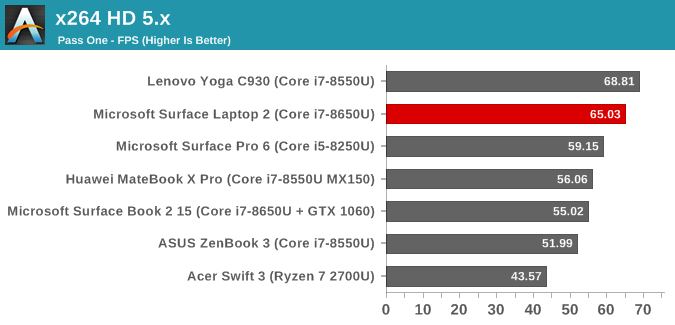
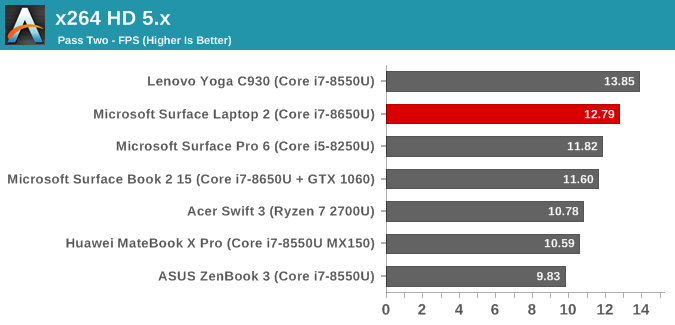
The x264 test is a very long benchmark running four times in a row and can easily take an hour to complete. As such it’s a great test to see CPU performance on a heavy load which will max out the cooling. Microsoft’s Surface Laptop 2 performs quite well here.
Web Results
Browser performance is a major factor in any web-based scripting, and we can see performance scores on the same device change dramatically over time as browsers are updated. Usually the performance trend is upwards, but not always. We standardize on Microsoft Edge for browsing tests.
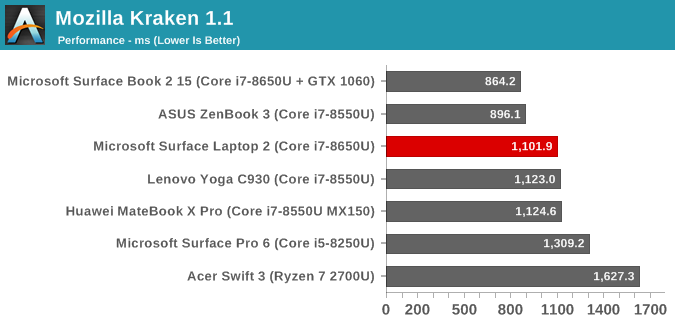

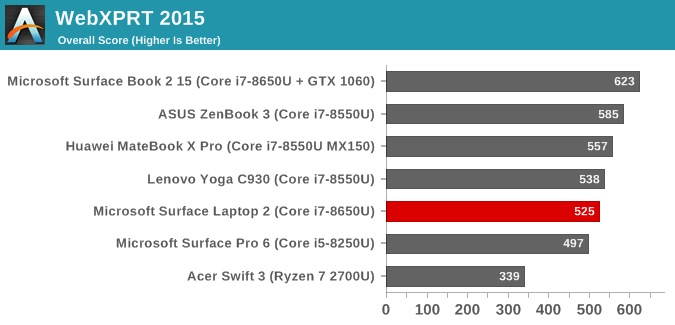
This is one area where Intel tends to hold a lead over AMD thanks to Intel’s work on Speed Shift, which lets the CPU ramp up to maximum much quicker, and that’s important in web results because web workloads are so short. The Surface Laptop 2 with its Core i7 is more or less in-line with the rest of the Core i7 models, where you’d expect it to be.
CPU Conclusion
The Surface Laptop 2 will offer significantly more performance than the original, thanks to the move to quad-core Kaby Lake Refresh. As you can see from the above results though, there’s not a lot of performance difference between the devices which tend to share a common platform underneath. Manufactures just need to make sure they offer enough cooling, and the Core i7 does the rest.











59 Comments
View All Comments
AsParallel - Thursday, March 28, 2019 - link
Microsoft wants to ensure you can't install Linux on it. The entire surface line is garbage for development, meanwhile windows had been bleeding developers by the thousands. The surface dock staunches that bleed by ensuring 0 compatibility.sbrown23 - Thursday, March 28, 2019 - link
But they do provide several different distros for Windows Services for Linux, easily downloadable from the Store.The Average - Saturday, March 30, 2019 - link
Why? Ubuntu 18 works like a charm in my SP3. And being a software developer I can tell you that Surface Pro is really great for that. The only thing I don't like in my SP is Windows which I still can't remove because I use some windows only applications.smilingcrow - Monday, April 1, 2019 - link
And the majority of us just yawn at your Linux drooling.DigitalFreak - Thursday, March 28, 2019 - link
Won't be buying one since they insist on sticking with their stupid Surface Connect Port instead of USB-C or Thunderbolt 3.id4andrei - Thursday, March 28, 2019 - link
No one in the real world cares about USB-C and even less about TB. The single USB-A port is better than a single USB-C port, for now. The Connect port is brilliant and it's good that it's a mainstay on the Surface line.DigitalFreak - Thursday, March 28, 2019 - link
"No one in the real world cares about USB-C"Keep telling yourself that, buddy.
The Average - Saturday, March 30, 2019 - link
I still haven't find a use for a USB-C. All my peripherals are type A. But no matter what port you have in your device you will find yourself buying a usb hub with several USB-A ports to expand that single USB Type A/C port.c4v3man - Thursday, March 28, 2019 - link
USB-C is required for universal docking. Thunderbolt is a great upgrade, that enhances dock reliability and performance in my experience. The Connect Port is a joke, and the ONLY way such a proprietary port would be deemed acceptable is if it fixed standard port flaws, by being far more capable, or more reliable. The Surface Dock is neither of these things, and is just as reliable as a USB-C dock (aka, reliable enough for most but not 100% reliable), but not as reliable as Thunderbolt. Microsoft needs to get with the program ASAP and adopt USB-C at a minimum, and preferably Thunderbolt on at least some of their models. Strike 1.Then again, Microsoft continues to use garbage Wifi chipsets on ethernet-less systems, so the WiFi needs to be the best in the market if they're playing in the premium space. Strike 2.
Finally, systems should be at least mildly serviceable, or otherwise boast "worlds thinnest/lightest/?". Microsoft doesn't boast these things, so 3 strikes... you're out.
Honestly, if they would fix one of these things, I'd consider it. No machine is 100% perfect. But this "unholy trinity" will prevent me from considering any of their machines, short of a surface book 2 (since it has USB-C), however my experience with a detachable display is that I basically never use the feature (1 day a year maybe), so I'd rather have a traditional hinge. So even the surface book 2 isn't much of a contender, but would at least warrant consideration.
Gunbuster - Friday, March 29, 2019 - link
You had to remind everyone about the Avastar ;) Ugg the worst WiFi/Bluetooth in the business.This is rehash what? 30 now? Thirty products in a row Microsoft has used the most buggy and under performing WiFI chipset in the industry...